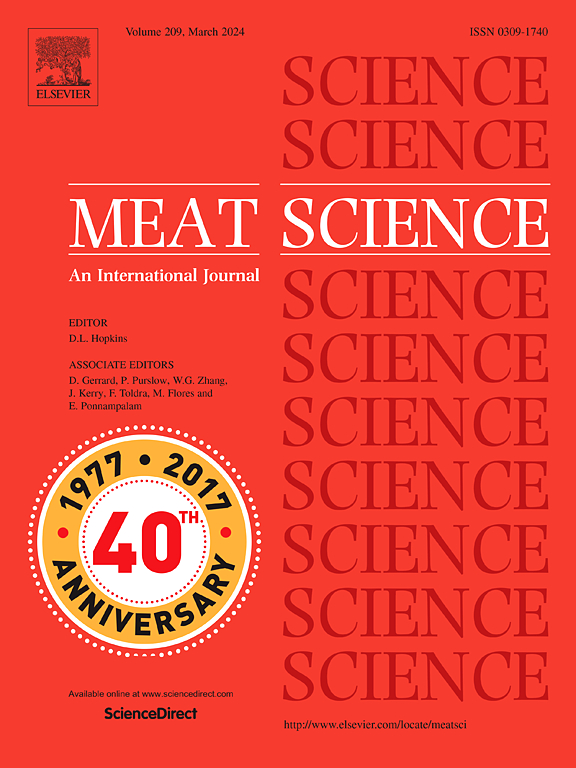Relating the Canadian and Japanese beef grading sites
IF 6.1
1区 农林科学
Q1 Agricultural and Biological Sciences
引用次数: 0
Abstract
The potential applicability of this study lies in the ability to use Canadian grades to segregate carcasses that are likely to achieve Japan Meat Grading Association (JMGA) grades ranging from JMGA 3 to low JMGA 5 in marbling. The findings indicate that high Canada AAA grades correspond to high JMGA 3 and low JMGA 4 grades. Carcasses classified within the Canada Prime quality grade are predominantly aligned with high JMGA 4 and low JMGA 5.
Moreover, a significant proportion of carcasses (66.7 %) within the Canada 1 retail cut yield class were comparable to JMGA A, whereas Canada 2 and 3 were largely aligned with JMGA B. The frequency analysis further revealed that Canada 4 retail cut yield carcasses were more likely to be classified as JMGA B (63.5 %) and JMGA C (36.5 %). However, the frequencies within Canada 5 and the Japanese estimated yield showed inconclusive results, with carcasses potentially qualifying as either JMGA B or JMGA C.
These estimations could provide valuable insights for the beef industry, enabling the segregation of carcasses based on Japanese market requirements. By using Canadian grades, it may be possible to identify and segregate those carcasses that could potentially achieve JMGA 3 to low JMGA 5 marbling grades, thus meeting the specific demands of the Japanese market.
有关加拿大和日本牛肉分级地点
这项研究的潜在适用性在于能够使用加拿大等级来分离可能达到日本肉类分级协会(JMGA)大理石花纹等级从JMGA 3到低JMGA 5的胴体。结果表明,高的加拿大AAA级对应高的jmga3级和低的jmga4级。在加拿大优质等级内分类的胴体主要与高jmga4和低jmga5对齐。此外,在加拿大1号零售减产等级中,有很大比例的胴体(66.7%)与JMGA a相当,而加拿大2号和3号在很大程度上与JMGA B一致。频率分析进一步显示,加拿大4号零售减产等级的胴体更有可能被归类为JMGA B(63.5%)和JMGA C(36.5%)。然而,加拿大5和日本估计产量的频率显示出不确定的结果,胴体可能符合JMGA B或JMGA c。这些估计可以为牛肉行业提供有价值的见解,使胴体能够根据日本市场需求进行分离。通过使用加拿大牌号,有可能识别和分离那些可能达到JMGA 3到低JMGA 5大理石花纹等级的胴体,从而满足日本市场的特定需求。
本文章由计算机程序翻译,如有差异,请以英文原文为准。
求助全文
约1分钟内获得全文
求助全文
来源期刊

Meat Science
工程技术-食品科技
CiteScore
12.60
自引率
9.90%
发文量
282
审稿时长
60 days
期刊介绍:
The aim of Meat Science is to serve as a suitable platform for the dissemination of interdisciplinary and international knowledge on all factors influencing the properties of meat. While the journal primarily focuses on the flesh of mammals, contributions related to poultry will be considered if they enhance the overall understanding of the relationship between muscle nature and meat quality post mortem. Additionally, papers on large birds (e.g., emus, ostriches) as well as wild-captured mammals and crocodiles will be welcomed.
 求助内容:
求助内容: 应助结果提醒方式:
应助结果提醒方式:


